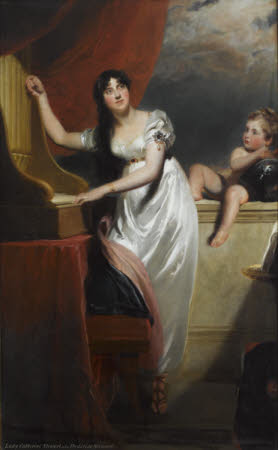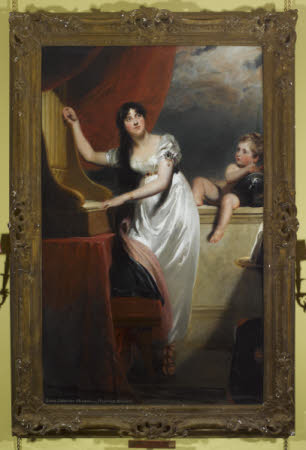Lady Catherine Bligh, Lady Charles Stewart (1774-1812) as Saint Cecilia and her Son, Frederick William Robert Stewart, later 4th Marquess of Londonderry (1805-1872)
Sir Thomas Lawrence, PRA (Bristol 1769 – London 1830)
Category
Art / Oil paintings
Date
1805 - 1812
Materials
Oil on canvas
Measurements
2337 x 1473 mm (92 x 58 in)
Place of origin
England
Order this imageCollection
Mount Stewart, County Down
NT 1542326
Caption
Lady Catherine Bligh (1774-1812) – the youngest daughter of the 3rd Earl of Darnley - was the first wife of Lord Charles Stewart (1774-1812) whom she married in 1804. Their son, Frederick William Robert Stewart (1805-1872) succeeded as 4th Marquess of Londonderry in 1854. He is seen here as an infant putto, or amoretto, with a helmet, perhaps alluding to the mythological God Mars who was conquered by love. Catherine is portrayed alongside an organ, apparently as Saint Cecilia, the patron saint of music. However, it seems likely there is a conflation of references. Erato, the muse of lyric and love poetry, and Euterpe, the muse of music, are subtly being hinted at.
Summary
Oil painting on canvas, Lady Catherine Bligh, Lady Charles Stewart (1774-1812) as Saint Cecilia and her Son, Frederick William Robert Stewart, later Viscount Castlereagh and 4th Marquess of Londonderry (1805-1872) by Sir Thomas Lawrence, PRA (Bristol 1769 – London 1830), circa 1807. Identifying inscription, lower left. A full-length portrait of the first wife of Sir Charles Stewart, later 3rd Marquess of Londonderry, with their son, the Hon. Frederick Stewart. She is leaning against the edge of a parapet, in a white dress, her hands resting on a musical table organ on the left; Frederick, in the guise of a naked putto, sits on the parapet behind her, to the right, leaning on a helmet.
Full description
Oil painting on canvas, Lady Catherine Bligh !1774-1812), first wife of Lord Charles Stewart, apparently as St Cecilia, with her son, Frederick William Robert Stewart, later Viscount Castlereagh and 4th Marquess of Londonderry (1805-1872). Catherine married Charles Stewart, later 3rd Marquess of Londonderry, in 1804. She is seen leaning against a stone parapet, wearing a white dress, with her dark brown hair loose, and playing a musical table organ. Behind her, seated on the parapet is Frederick in the guise of an infant putto, leaning against a helmet. Catherine may be assumed to represent either St Cecilia the patron saint of music, or Euterpe, the muse of music, while her son refers to Mars the god of war, who was conquered by love. The combined reference links this double portrait to the absent father, Charles Stewart, who spent much of the married life away in serving in the Peninsular Wars as Adjutant General to Arthur Wellesley. It was during one of his periods of service abroad, in 1812, that Catherine succumbed to the after-effects of a relatively minor operation to remove a cyst from her head, to Charles's lasting anguish. During her last illness Charles's older half-brother, Robert Stewart, Viscount Castlereagh and his wife Emily, cared for Catherine "tending her with loving care" (Edith Londonderry, Frances Anne, 1958). In a miniature also at Mount Stewart (NT1220844), Catherine is portrayed with a harp, suggesting that she was genuinely a keen musician. Charles married a second time, in 1800, to Frances Anne Vane Tempest. In a drawing of the Drawing Room at Mount Stewart in 1856, shortly after Frederick had inherited the title on his father's death in 1854, this painting appears in a central position between the two fireplaces. (F Bailey, 2024)
Provenance
The Coutts list records a portrait for 'Lady Catherine Bligh (now Lady Stewart)' at a price of £147; by family descent; accepted in lieu of inheritance tax by HM Government and allocated to the National Trust for display at Mount Stewart, 2013.
Makers and roles
Sir Thomas Lawrence, PRA (Bristol 1769 – London 1830), artist
References
Garlick 1989 Kenneth Garlick, Sir Thomas Lawrence. A complete catalogue of the oil paintings, Oxford, 1989, 743 Armstrong, 1913: Sir Walter Armstrong, Lawrence, London, 1913, p. 164

